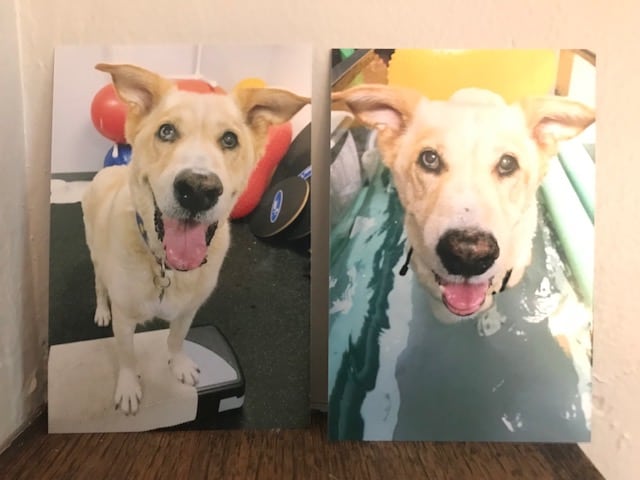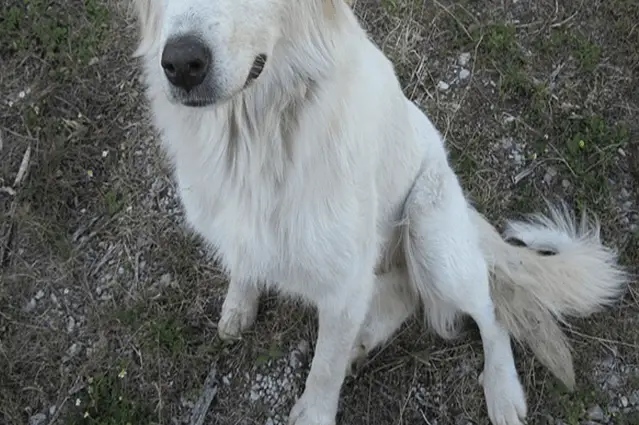Some content may contain affiliate links to products which means we could earn a fee on your purchase. Thank you for visiting
Yesterday, my dog came out of his physical therapy session with a festive halloween bandana tied around his neck. He looked so cute and it occured to me “hey, I know this bandana” it’s the same one he received exactly one year ago when he was brand new to doggie physical therapy.
Wow! It doesn’t feel like he’s been in physical therapy for a year, but here we are. One full year later, and it’s times like that I’m so thankful for taking action when it would have been so easy to chalk it all up to “old age.”
Anyway, as the saying goes, hindsight is 20/20. And in this article, I want to share what happened over one year ago, when our dog had trouble getting up, but walked fine on his daily walks. I’ll share what we were experiencing and the signs he was displaying that made us schedule a session with vet who was into therapy.
Dog Has Hard Time Getting UP – What We Saw
It was over a year ago, Frodo, my now 13.5 year old, 90 pound senior dog displayed these exact symptoms while we were visiting family. Of course at his age, he had already been diagnosed with advanced arthritis but something had changed.
All of a sudden instead of just being stiff or limpy, he actually had trouble getting up. What made it a little more confusing was that he was perfectly fine on walks.
Trouble Getting Up – What we Saw Visually
My dog is large, with a big chest, but has lanky legs. That means he’s top heavy toward the front of his body. So he’d get his front legs up, but his hind end stayed exactly as though he was still laying down.
I watched him strain nearly every time he attempted to go from laying to standing. Eventually, I would go over to give him and hoist him up from his back end.
Now those of you that follow my stories know that we are managing Frodo’s arthritis in many different ways and it’s been going rather well all things considered. But since the behaviour continued for several days, we thought it best to call the vet and describe the new behavior.
Our Vet Visit for Trouble Getting Up and Laying Down
Since the straining continued, we wanted to be sure he hadn’t pulled a muscle or tendon and we really wanted to rule out whether it was something serious. Thinking back, I think we were hoping to hear that he had just strained himself, after all… he did still chase after bunnies!
After a thorough exam and with all bad things ruled out, the vet took out some angular measuring devices and started measuring Frodo’s range of motion and his muscle mass.
Long story short, his range of motion was terrible, like as bad as it could be. And his muscle mass was on the low end, bordering on dangerously low. And because he had no flexibility and not enough leg muscles, it was clear that he was using his core muscles to compensate for all of his disadvantages.
I distinctly remember one of the vet tech’s saying that some dogs strain so hard to get up, they end up defecating. That’s because the dog is using their core muscles instead of their leg muscles. As a result of the core strain, they actually release their bowels.
Dog Unable to go from Laying to Standing – Prescription: A Round of Physical Therapy
So after a thorough explanation and a new understanding of arthritis vs. range of motion, vs. loss of muscle, we were sent home with an extensive packet to review for their options of physical therapy.
It wasn’t cheap. It was going to be a commitment of time and money. Twice a week for 4 weeks and we also had to commit to homework exercises.
Fortunately for us, we are consistent savers and always make sure we set aside funds for the unknown, especially with a house full of senior animals. So we said yes to what was going to be roughly $60/session which was going to cost about $480 that month.
That decision was about 1 full year ago and the results have been incredible. More than incredible. In fact, the results were so good, we decided to keep him in physical therapy even after his prescribed month and he continues to go once per week.
Here are some pictures of Frodo just a few weeks ago that PROVE how much he loves physical therapy! Can you believe this guy is 13.5?

And seeing him come out of therapy yesterday, and seeing that bandana, reminded me that we once had the same questions and the same problems and didn’t know what to do.
The bandana brought back memories and inspired me to write this article and share how it all went down for us a year ago when our dog had trouble getting up.
Other Signs Your Dog Could be Losing Muscle or Has Bad Range of Motion
Here are 2 other symptoms that Frodo exhibited before we confirmed that he was losing muscle mass in his hind quarters and had horrible range of motion…
Rough Lay Downs – a sign that your dog might be losing muscle is if she falls roughly when going into a lying position. You can actually hear a “thud” vs. lying down softly and gently, quietly. If you’re unsure, just have a listen next time your dog lays on the floor.
Circle Start and Stop – In addition to laying down hard, we noticed that Frodo would circle several times and TRY to lay down. But he wouldn’t be able to. He’d walk a few feet away, circle and try to lay down again. Sometimes this went on multiple times before he’d be able to lay down.
Conclusion
Arthritis. muscle loss and limited range of motion are different problems. Even with advanced arthritis, for a very long time our dog was able to go from lying to standing without issue.
However, once he had problems getting up, it was no longer about arthritis. He was beginning to lose muscle at an uncomfortable rate and his range of motion was so limited. He compensated by using his core which made his body even more sore.
Physical therapy has built his muscle and his stretching exercises drastically improved his range of motion. My 13 year old severely arthritic dog still goes up 2 flights of stairs every night to join us in the master bedroom.
I am forever thankful for the support of our vet and vet techs and so glad we took the plunge into physical therapy.
Thanks for visiting SeniorDogDays!

